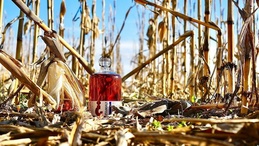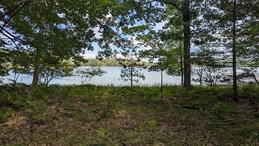The debate over using weed killer on Lake Michigan reeds
Aug. 16, 2009
It’s a Jungle Out There...The debate over using weed-killer on Lake Michigan’s reeds
By Anne Stanton 8/17/09
When you get put on hold at the Watershed Center of Grand Traverse Bay, you’ll hear bits of environmental advice such as avoiding lawn fertilizers near the bay.
But now the environmental group is supporting a plan to put Rodeo—pretty much the chemical equivalent of the weed-killer Roundup — into Lake Michigan in order to kill a reed called phragmites (frag-MIGHT-eez).
You can see patches of the 13-foot reeds swaying in shallow water from Northport to Charlevoix. Unlike the native phragmites that have been here for thousands of years, this European exotic plant arrived in the Atlantic seaports sometime in the early 1800s, according to research by Kristin Saltonsall of Yale University.
Unlike the native phragmites, it pushes out native vegetation and ultimately becomes such a thick mass, it’s inhospitable to other living creatures, said Brian Piccolo, a wildlife habitat biologist who is anxious to get rid of the reed before it spreads.
Phragmites is new to the area and often takes root where the dirt has been disturbed from construction or on newly-exposed shoreline. Some believe that the die-off of zebra mussels is creating a rich bed of nutrients that phragmites need to thrive.
The Department of Natural Resources has received a $120,000 grant for contractors to spray herbicides on the affected shorelines, beginning in late August when the plant is most porous. Next year, it will spend $50,000.
CONFLICTED
There are no plans for an aerial spray; it will be mostly applied by contractors wearing backpacks of the herbicide, or hand swiped where endangered plants thrive. Although the Watershed Center has endorsed the spraying, the staff feels conflicted.
“For us, this isn’t a comfortable place to be. We don’t like to use herbicides. We want to make sure it’s done early, so we use less herbicide, and to use it comprehensively to get the infestation quickly under control,” said Ellen Kohler, the Watershed Center’s policy analyst. “But we’re not out there advocating herbicides as a general matter.”
John Nelson, the Baykeeper of the Watershed Center, owns a Northport cabin where phragmites has taken root. He says it has pushed out native plants to the detriment of the birds and insects that depend on them.
“I’m not too concerned about the cosmetics if you will, or how it blocks the view. For me, it’s more of a habitat issue. It becomes a monoculture. I think the shoreline is better off if it has the various indigenous plants growing in harmony. Over a long period of time, nature has a tendency to balance it out and the phragmites will recede. Short term, we need to control the plant.”
But the plan to use Rodeo has led others to speak up, believing that Rodeo will either fail in the long run or hurt nature in unintended ways.
“To turn around and add more poisons to an already damaged environment by calling these plants invaders and deluding ourselves of the botany and biology of the situation strikes me as criminal actually,” said Jim Moses, an organic farmer in Leelanau County. “We have a feeling of dominance over others, over creation that I don’t feel is justified. I see no place in using toxins that we don’t understand very well. Have we not learned the lessons of Silent Spring (a landmark book by Rachel Carson written in 1962, revealing the impact of DDT)? It’s time for a more open debate. I’ve been very frustrated that everything has been planned in one voice with no room for dissent.”
SUCK-UP SITUATION
In nature, everything has a role, and the function of phragmites is to suck up the excess nutrients along the shoreline. “If you kill the plant, then the nutrients that the plant is taking up into biomass will go unimpeded into Lake Michigan,” Moses says. “That might prove toxic to some species or alter conditions to favor more opportunistic creatures. I’m not saying I know the consequences. My concern is, in our attempt to eliminate this plant, which is flourishing, we might have unforeseen consequences. The advocates of the poisonous path say it’s nailed down science, but it’s not as nailed down as people want.”
Moses questions whether native grasses will grow in place of the phragmites and disputes that the reed is inhospitable to other species. He cites a study by Richard Kane on the New Jersey Audubon Society website. Kane listed 33 birds that nest, breed, take cover, and hunt fish in phragmites swamps or marshes.
But Kohler said that management of a marsh is entirely different than a lake shoreline. “What I do know is that the diversity of birds and insects that thrives in an invasive species is much, much lower than what depends on native habitat. Do you wait and study everything, and then end up with a huge problem and an expansive change to our shoreline?”
UNFAZED
What a homeowner might regard as unwelcome vegetation is regarded by the DEQ as habitat for fish, birds and wildlife. For that reason, beachfront owners must obtain the state’s permission before making changes to the waterfront, whether it’s putting in a break wall or disturbing vegetation.
That’s why Mary and Mike Forness who live on East Grand Traverse Bay have been unfazed by the plants and trees that now inhabit their once sandy beach. It all began about 10 years ago, when the water level receded.
Gradually the water’s edge was filled by a thick mix of trees, cattails, bushes, and phragmites.
Mary said she was willing to “live with it” because she didn’t want to disturb the ecosystem. That’s why she was surprised to receive a survey letter from Acme Township regarding the chemical treatment of phragmites.
Forness said she had a lot of questions, and went to a recent Acme Township meeting where Kohler made a presentation.
“Just dumping something into our bay where we swim, that alarms me. But everyone at the meeting said, ‘We’re okay with it, we’ll send in our survey.’ But I think, ‘Really? Don’t you want to know what’s in the herbicide?’ What surprised me was that it seemed to be a done deal. It seemed like they had already made the decision to use Rodeo and another herbicide and that they were just waiting to complete the survey before going with it.”
Yet Forness had a lot of questions, including whether the herbicide was a threat to humans or aquatic life.
The active ingredient of Rodeo is glyphosate, which kills plants, but has not been found to harm fish or birds. It’s an eye irritant for humans, and lethal if swallowed in large quantities.
But there’s a little known wrinkle to Rodeo.
For maximum effectiveness, the label requires the addition of a surfactant -- a detergent that strips the surface of a leaf and allows glyphosate to enter the plant’s stems and leaves. But many common surfactants are lethal to fish and frogs, according to research by Rick Relyea, an associate professor and director of the Pymatuning Laboratory of Ecology.
“A surfactant is used to cut through the waxy surface of a plant. The waxier it is, the harder it is for the glyphosate to get in. If you waxed your car and it rained, the rain would roll right off. Glyphosate on waxy leaves works the same way. Without a surfactant it would roll right off the leaf and never get into the plant,” he explained.
“Unfortunately, fish have cell membranes made of lipids or fats and the surfactant, which is really good at dissolving waxy leaves, is also good at dissolving the lipids on the gill cells. Surfactants make gill cells burst and the fish suffocates. So a surfactant that is good at killing plants is inherently also good at killing fish and tadpoles.”
KILLS AMPHIBIANS
In a pond study of 25 species, including insects, snails, and tadpoles, Relyea found that Roundup (which contains glyphosate, the same as Rodeo) caused a 70 percent decline in amphibian diversity and an 86 percent decline in the total mass of tadpoles. Although spring peepers were unaffected, leopard frog tadpoles and toad tadpoles were nearly eliminated.
His research tested a popular surfactant of glyphosate called polyethoxylated tallowamine, which was fatal to tadpoles.
“Surfactants don’t have to be tested by the EPA -- they’re not regulated, and they never have been. They are categorized as an inert ingredient, which means their identities are kept as trade secrets and they don’t have to be tested,” Relyea said.
Surfactants are even lethal when used in lower than recommended doses and in the presence of soil, a follow-up study showed.
Nelson, who knew of the deadly effect on amphibians, said that the licensed applicator will not use a surfactant in Leelanau County on phragmites, which does not have a waxy leaf.
However, a surfactant will be used in other areas, as it was used at Beaver Island, said Piccolo, who didn’t know what surfactant will be used.
Relyea said another drawback is that Rodeo isn’t selective. It kills every plant it touches.
“Will you kill both invasive plants and native plants? It’s hard to know. If you apply the herbicide to a few test areas, you’ll have a better idea than if you apply it broadly. Try a few areas and see what plant species come back next spring,” he said.
Kohler said the application is far more focused with a backpacker directly spraying the reeds, as opposed to an aerial application. But she also added that not all vegetation is necessarily good. Besides phragmites, there are other invasive plants that should be eliminated, including knapweed, narrow leaf cattail, and red canary grass.
“The DNR said they’d be thrilled if these went away, too,” she said.
OTHER SIDE
Pam Grassmick said the potential downside of surfactants makes it imperative that the herbicides are professionally applied. She has overseen a three-year control effort on Beaver Island, which is being used as a model for the Grand Traverse region.
Grassmick, like everyone else confronting the problem, went through an intensive education process. Burning phragmites doesn’t work, and neither does pulling the reed. Floating pieces of root will produce new shoots. The plant spreads with rhizomes -- long tubular roots -- as well as by seed. So the community went with the use of herbicides.
“We started three years ago, and we had 27 acres growing along our shoreline. We really attacked it as a community. We did a lot of education with property owners, we formed a collaborative of property owners, the townships, the DNR and we really went at this.”
This is the third year for the herbicides, and a new survey shows that less than half an acre of phragmites remain. And the 50-foot runners that trailed along the beach are gone.
“By acting early to control this, it was so much easier than waiting. If you go to Saginaw Bay, which is full of phragmites, they’re spending millions of dollars and using helicopters to apply it. “I went to Warpole Island in the mouth of St. Clair River, and it’s awful. They have acres and acres of it. It’s so thick, the turtles can’t get on the island. The people on the island cut little paths on the water so the deer can climb ashore between the islands. It’s that thick.
Grassmick said they used two herbicides —glyphosate and Imazapyr—along with a surfactant. However, she did not see any dead fish or amphibians. She frequently walks the shoreline, and saw tadpoles swimming at a former phragmites site, she said.
Anyone tackling this problem should hand-wipe areas in which endangered species are growing, and to be careful not to kill any other vegetation when spraying, she said.
“We went to Harsens Island (in Michigan), and there’s one man there who believes in arming every property owner with their own spray can. We had individuals who were getting the stuff without a permit, not using the correct chemicals, and not identifying the proper plant,” she said. “We’ve been very cautious – it couldn’t be applied if the wind conditions are over five mph. There are all sorts of controls built into this.”
TEMPORARY FIX?
A U.S. Forest Service report said that phragmites has 26 natural predators, including five native to this country. Scientists at Cornell University are trying to find a biological answer to killing the plant, much like weevils are now being used to control milfoil in inland lakes. But the answer won’t come in time for this area, Piccolo said.
Roger Knutson, a Charlevoix resident and retired professor of botany, believes that nature will take its course, although not on a timescale humans prefer.
“Already at the township level, there’s an urge to have zoning laws, ordinances prohibiting the presence of phragmites in your township, and that’s right close to silly, it seems to me. It’s a little bit like prohibiting dandelions and just about as effective.”
“The effect on any other set of organisms will be very, very small. It won’t eliminate any other kind of plant. In the whole history of botany, there is no example of a plant from some other place that invaded and eliminated some other plant already there. It’s never happened. … The world is sufficiently complicated and it pretty well takes care of itself -- just not on a timescale we would like.”
Picollo couldn’t disagree more.
“I did my graduate research in Chicago, where there is horrible phragmites. You’ll see huge swamps and lakes that are nothing but phragmites from shore to shore. It’s growing, growing, growing, with nothing to keep it in check.
“I don’t know anyone who says to let nature take its course—to sit back and watch phragmites replace all native vegetation. For me as a wildlife biologist, I wouldn’t be doing my job if I let that happen.”
Trending

Farm to Glass with Ethanology
When Elk Rapids distillery Ethanology committed to locally-sourced ingredients for their products, it seemed like they&rsquo… Read More >>
MRKT HLDY SHPPNG, aka Warehouse MRKT Holiday Shopping!
Shop the latest from local makers and vendors at the Holiday MRKT Share at Warehouse MRKT in TC, Saturday, Dec. 20, from 10a… Read More >>
Men and Ugly Sweaters
Those two things don’t always go together, but on Dec. 19, you’ll see both out and about in Petoskey and Harbor … Read More >>


